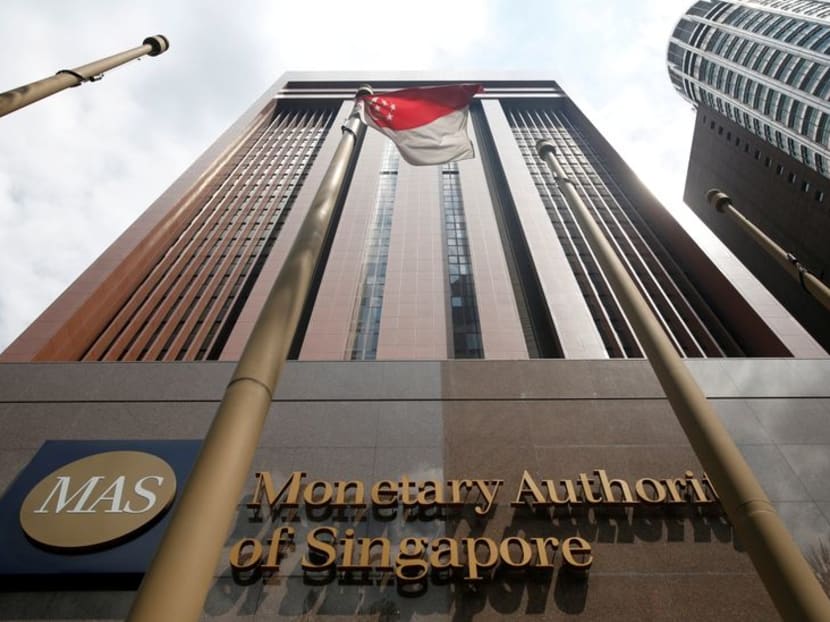MAS tightens Singdollar policy in surprise move to 'ensure price stability over the medium term'

FILE PHOTO: A view of the Monetary Authority of Singapore's headquarters in Singapore June 28, 2017. Picture taken June 28, 2017. REUTERS/Darren Whiteside/File Photo
SINGAPORE: The Monetary Authority of Singapore (MAS) bucked market expectations to tighten monetary policy on Thursday (Oct 14), a move that it said will help to “ensure price stability over the medium term” amid higher inflation.
In its half-yearly monetary policy statement, the Singapore central bank said it would “raise slightly” the slope of the Singdollar nominal effective exchange rate (S$NEER) policy band from zero per cent previously.
The width of the policy band and the level at which it is centred remained unchanged.
“This appreciation path for the S$NEER policy band will ensure price stability over the medium term while recognising the risks to the economic recovery,” the MAS said.
It added that growth in the Singapore economy is likely to remain above trend in the quarters ahead. Barring a resurgence of COVID-19 globally or a setback in the pace of economic reopening, "output should return to around its potential in 2022".
At the same time, external and domestic cost pressures are accumulating, reflecting both normalising demand as well as tight supply conditions, it said.
It expects core inflation – which excludes accommodation and private transport costs – to rise to 1 to 2 per cent next year, and close to 2 per cent in the medium term.
Eleven of 13 economists polled by Reuters had predicted that the central bank would stand pat on its monetary settings. Only two expected the MAS to tighten slightly and begin normalising policy.
The tightening move takes MAS away from a “zero per cent” appreciation rate of its policy band adopted in March last year, when the economy first started the squeeze of the COVID-19 pandemic.
This also marked the central bank's first policy tightening move since 2018 when it increased the slope of the Singapore dollar’s policy band twice that year to allow for “a modest and gradual” appreciation.
Related:
Unlike most central banks that manage monetary policy through the interest rate, the MAS uses the exchange rate as its main policy tool.
This refers to the S$NEER – the exchange rate of the Singapore dollar managed against a trade-weighted basket of currencies from Singapore’s major trading partners.
The S$NEER is allowed to float within an unspecified band. Should it go out of this band, the MAS steps in by buying or selling Singapore dollars.
The central bank also changes the slope, width and mid-point of this band when it wants to adjust the pace of appreciation or depreciation of the local currency based on assessed risks to Singapore’s growth and inflation.
The Singapore dollar nudged up against the US dollar following the announcement and was last seen trading at 1.3490 at 9.16am.
GROWTH AND INFLATION OUTLOOK
Preliminary data released separately on Thursday morning showed that Singapore’s economy grew by 6.5 per cent year-on-year in the third quarter, slowing from the 15.2 per cent growth in the previous quarter.
The MAS, in its report, said the Singapore economy is expected to “sustain a firm pace of growth” in the quarters ahead, on the back of strengthening external demand and recovering domestic expenditure.
Growth in the trade-related and modern services sectors will be supported by the resilient electronics cycle and improving business activity. The domestic-oriented and travel-related clusters may also see some improvement as Singapore transitions towards living with COVID-19 as an endemic, it added.
“Barring the materialisation of tail risks such as the emergence of a vaccine-resistant virus strain or severe global economic stresses, the Singapore economy should remain broadly on an expansion path,” the MAS wrote.
“The slack in the labour market should continue to be absorbed and the negative output gap close in 2022.”
Meanwhile, core inflation – a key policy consideration for the MAS – rose to a two-year high of 1.1 per cent in August.
This mainly reflected higher global commodity prices, which passed through to electricity and gas tariffs and non-cooked food inflation. At the same time, higher wage costs have fed inflation in some domestic consumer items such as food and beverage services, said the central bank.
In the coming quarters, inflation is set to see a “broad-based pick-up” due to rising imported and labour costs, as well as the recovery in domestic activity.
“Imported inflationary pressures are likely to persist for some time amid strengthening global demand and lingering supply constraints. On the domestic front, wage growth is likely to be firm alongside the dissipation of labour market slack through next year.
“The accumulating business costs will pass through to consumer price inflation as the domestic economy reopens and private consumption recovers. Various service fee increases that were put on hold since the pandemic began, such as for transport, healthcare and education, could also resume,” it wrote.
Private transport inflation is likely to moderate next year against a slower pace of increase in COE (Certificate of Entitlement) premiums and petrol costs. But accommodation inflation is expected to remain firm amid construction delays.
With that, MAS said headline inflation will come in around 2 per cent this year and average 1.5 to 2.5 per cent next year.





